Astronomy - This Week’s Sky at a Glance, November 25 – December 3
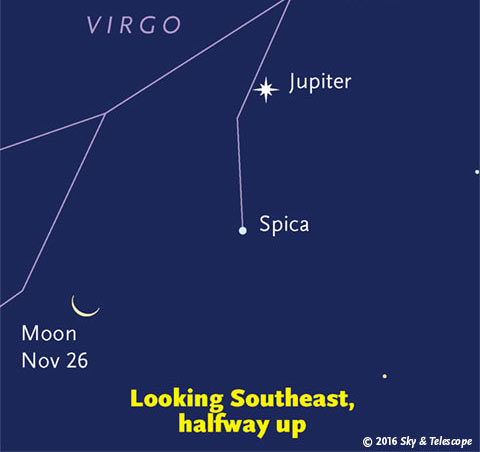
The Moon is waning down and away from Jupiter and Spica early on Saturday morning the 26th.
Friday, November 25
• Before and during dawn Saturday morning, the thinning crescent Moon in the southeast is at the bottom of an arc that it now forms with Spica and Jupiter, as shown here.
• The naked-eye eclipsing binary star Algol should be at its minimum brightness, magnitude 3.4 instead of its usual 2.1, for a couple hours tonight centered on 12:13 a.m. EST; 9:13 p.m. PST. Info and comparison-star chart.
Saturday, November 26
• By 10 or 11 p.m. now (depending in how far east or west you live in your time zone), the dim Little Dipper (Ursa Minor) hangs straight down from Polaris.
By that time, Orion has risen high in the southeast and Sirius is blazing below it.
Sunday, November 27
• Now that the Pleiades and (below them) Aldebaran are shining due east after dark, can Orion be far behind? Orion's entire iconic figure, formed by its brightest seven stars, takes about an hour and a quarter to clear the eastern horizon. By 10 p.m. it's well up in fine pre-winter view.
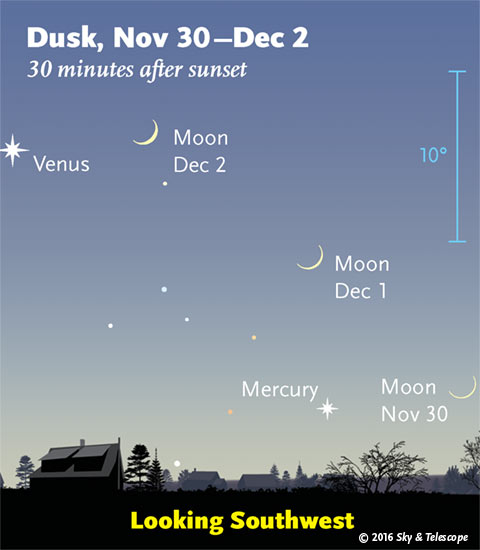
On what date will you first see the waxing crescent Moon? While the Moon is still low with Mercury, Venus helps to guide the way. (As always, the Moon is positioned for a skywatcher in the middle of North America. Its position may differ a bit for you.)
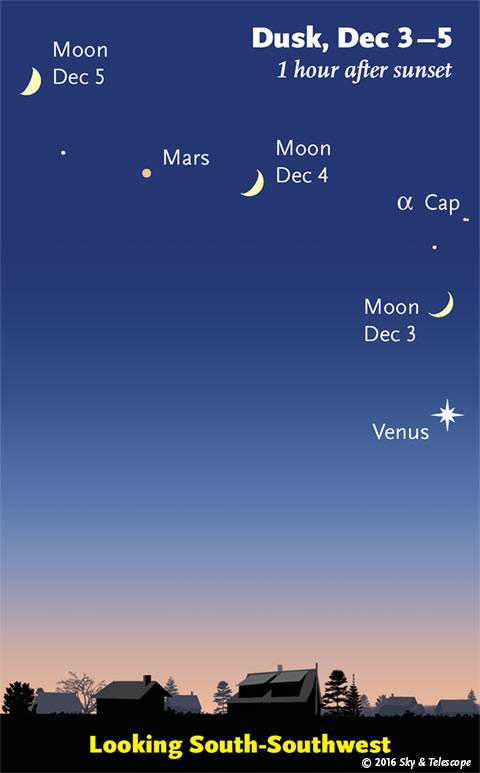
As the Moon waxes thicker and higher, it passes Venus and then Mars.
Monday, November 28
• Algol is at its minimum brightness, magnitude 3.4 instead of its usual 2.1, for a couple hours centered on 9:02 p.m. EST. Info and comparison-star chart.
Tuesday, November 29
• Two faint fuzzies naked-eye: The Andromeda Galaxy (M31) and the Perseus Double Cluster are two of the most famous deep-sky objects. They're both cataloged as 4th magnitude, and in a good sky you can see each with the unaided eye. They're located only 22° apart, very high toward the east early these evenings — to the right of Cassiopeia and closer below Cassiopeia, respectively.
To find exactly where to look, you'll need a good sky chart to pinpoint them. The all-sky constellation chart in the center of Sky & Telescopewill do just fine.
• New Moon (exact at 7:18 a.m. EST).
Wednesday, November 30
• Twilight challenge: Can you see Mercury and the super-thin crescent Moon? Starting about 15 minutes after sunset, use binoculars to scan for them just above the southwest horizon, about 25° to the lower right of Venus, as shown here. The Moon and Mercury are about 7° apart, with the Moon to the planet's right or upper right depending on where you are.
Thursday, December 1
• Now the Moon, slightly thicker, hangs about 10° above Mercury low in the southwest in bright twilight.
Friday, December 2
• For the next two evenings, the thickening crescent Moon does with bright Venus what it just did with faint Mercury while very thin. Look southwest at dusk. Venus and the Moon are 7° or 8° apart at the at the time of twilight for the Americas, with the Moon on the right. Although they may look like they're keeping each other company, Venus this evening is 370 times more distant than the Moon.
Saturday, December 3
• Now the thickening crescent Moon shines above Venus during and after dusk. They're once again about 7° apart for the Americas.
_________________________
Want to become a better astronomer? Learn your way around the constellations! They're the key to locating everything fainter and deeper to hunt with binoculars or a telescope.
This is an outdoor nature hobby. For an easy-to-use constellation guide covering the whole evening sky, use the big monthly map in the center of each issue of Sky & Telescope, the essential guide to astronomy.
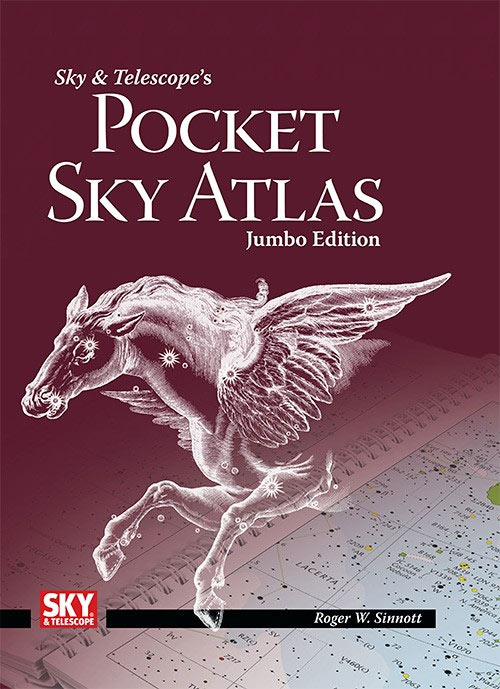
The Pocket Sky Atlas plots 30,796 stars to magnitude 7.6 — which may sound like a lot, but it's less than one per square degree on the sky. Also plotted are many hundreds of telescopic galaxies, star clusters, and nebulae. Shown above is the new Jumbo Edition for easier reading in the night. Click image for larger view.
Once you get a telescope,to put it to good use you'll need a detailed, large-scale sky atlas (set of charts). The basic standard is the Pocket Sky Atlas (in either the original or new Jumbo Edition), which shows stars to magnitude 7.6.
Next up is the larger and deeper Sky Atlas 2000.0, plotting stars to magnitude 8.5, nearly three times as many. The next up, once you know your way around, is the even larger Uranometria 2000.0 (stars to magnitude 9.75). And read how to use sky charts with a telescope.
You'll also want a good deep-sky guidebook, such as Sue French's Deep-Sky Wonders collection (which includes its own charts), Sky Atlas 2000.0 Companion by Strong and Sinnott, or the bigger Night Sky Observer's Guide by Kepple and Sanner.
Can a computerized telescope replace charts? Not for beginners, I don't think, and not on mounts and tripods that are less than top-quality mechanically (meaning heavy and expensive). And as Terence Dickinson and Alan Dyer say in their Backyard Astronomer's Guide, "A full appreciation of the universe cannot come without developing the skills to find things in the sky and understanding how the sky works. This knowledge comes only by spending time under the stars with star maps in hand."
This Week's Planet Roundup
Mercury (magnitude –0.5) and Saturn (magnitude +0.5) are hiding very deep in the glare of sunset, 25° or 30° lower right of Venus.
Venus (magnitude –4.2, in Sagittarius) shines brightly as the "Evening Star" in the southwest during and after twilight.
Mars (magnitude +0.6, crossing central Capricornus) still glows in the south-southwest at dusk, about 25° upper left of Venus. In a telescope it's a tiny orange blob just 6½ arcseconds in diameter.
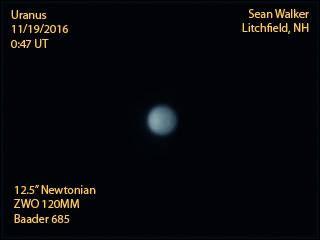
On the evening of November 18th "we were treated to some phenomenal seeing conditions," writes S&T's imaging editor Sean Walker, "though the humidity was so high my scope completely dewed over. Here is the one picture of Uranus I captured, showing the brighter north polar region at left." Also note the hint of a white band on the right. Walker shot this image through a near-infrared (685-nm) filter. Uranus was 3.7 arcseconds wide.
Jupiter (magnitude –1.8, in Virgo) rises around 2 or 3 a.m. and shines brightly in the southeast by early dawn. Look for Spica 8° or 9° under it at dawn, and Arcturus 30° its left or upper left.
Uranus (magnitude 5.7, in Pisces) and Neptune(magnitude 7.9, in Aquarius) are high in the southeast and south, respectively, shortly after dark. Info and finder charts.
__________________________
All descriptions that relate to your horizon — including the words up, down, right, and left — are written for the world's mid-northern latitudes. Descriptions that also depend on longitude (mainly Moon positions) are for North America.
Eastern Standard Time (EST) is Universal Time (UT, UTC, or GMT) minus 5 hours.
__________________________
"This adventure is made possible by generations of searchers strictly adhering to a simple set of rules. Test ideas by experiments and observations. Build on those ideas that pass the test. Reject the ones that fail. Follow the evidence wherever it leads, and question everything. Accept these terms, and the cosmos is yours."
— Neil deGrasse Tyson
— Neil deGrasse Tyson
No comments:
Post a Comment